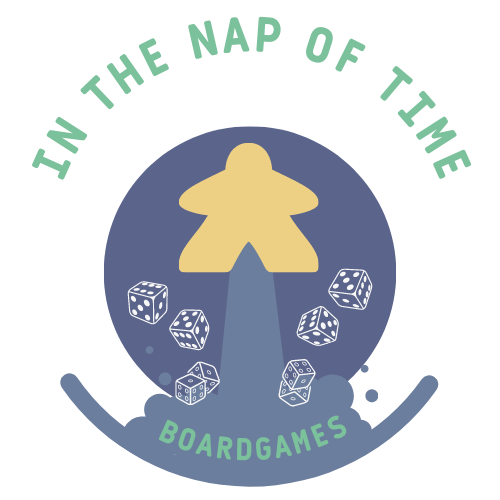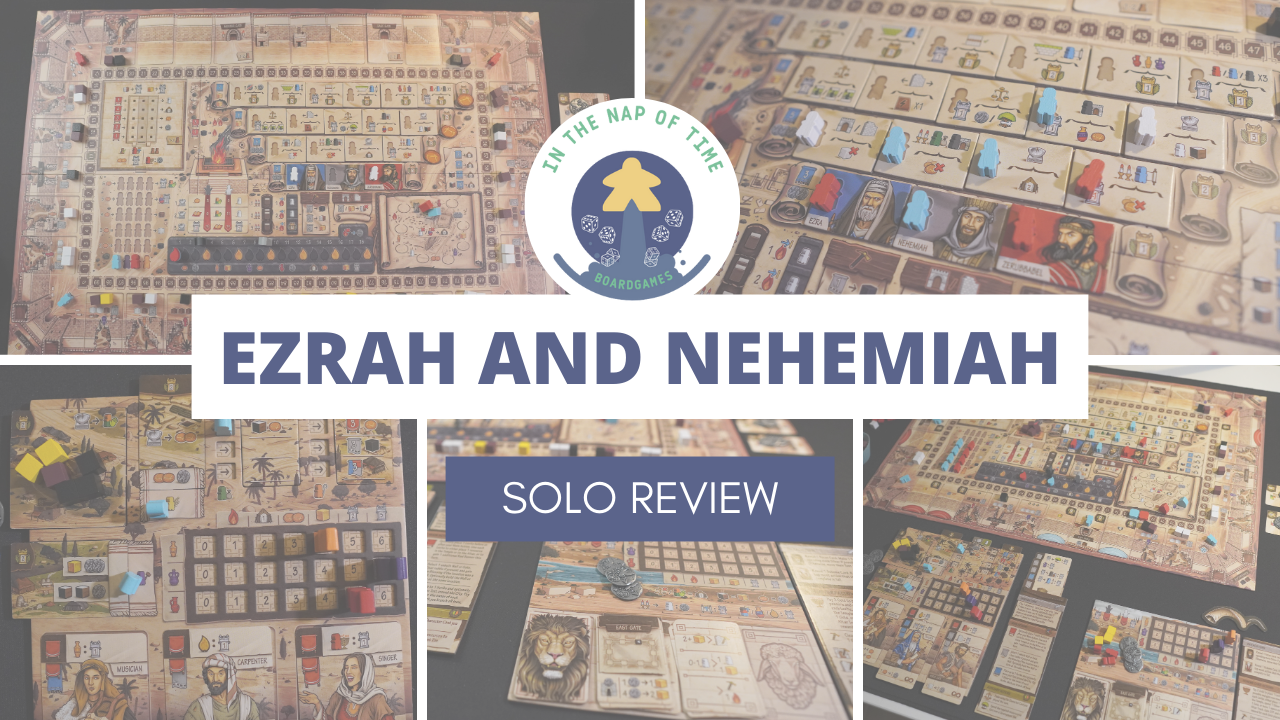Introduction
How can I describe this game? Imagine sort of rebuilding a city, one stone at a time, while navigating the complexities of ancient politics and religious obligations. That’s exactly what Ezra and Nehemiah, a board game by Shem Phillips and S J Macdonald, offers. In this review, I’ll delve into the details of playing Ezra and Nehemiah (solo), covering the rules, the look and feel of the game, and my personal thoughts on its solo gameplay experience.
If you’ve read reviews by me before you will know I’m a big fan of Garphill Games but for the sake of this review I will try to be as objective as possible!
If you just want my opinions on the game you can scroll down past How to play and Look and feel.

How to Play Ezra and Nehemiah
Overview
In Ezra and Nehemiah, you are tasked with rebuilding Jerusalem’s temple and city walls, teaching the Torah, and managing your resources over three rounds. The game is played over a series of workdays followed by a Sabbath, during which you score victory points based on your achievements.
Setup
Main Board Setup
- Place the Main Board centrally.
- Arrange Gate Cards and resources as specified.
- Randomly distribute Scroll Tiles and place Food tokens accordingly.
Player Board Setup
- Each player receives a Player Board, Development Tiles, Workers, and other components in their chosen colour.
- Resources are placed on specific spaces as indicated by the setup instructions.
Levite and Gatekeeper Setup
- Assign Levites and Gatekeepers according to player count.
- Place additional components as per the rules for fewer than four players.

Gameplay Structure
The game progresses over three rounds, each consisting of six workdays and a Sabbath. Players take turns performing actions such as playing Character Cards, taking Main Actions (Temple and Altar, Rubble, Walls, and Gates, or Torah and Tenting), and performing Auxiliary Actions like trading or developing tiles.
Main Actions
Temple and Altar
- You can use Red Banners to place resources in the temple or on the altar.
- Each Levite can be used to place one resource or provide additional Red Banners.
- Rewards are gained based on the row where resources are placed.
Rubble, Walls, and Gates
- Grey Banners are used to clear rubble and construct city walls and gates.
- Each type of resource requires a specific number of Grey Banners to clear.
- Once rubble is cleared, you can build walls or gates, gaining victory points and other rewards.
Torah and Tenting
- Blue Banners allow you to place Scribes on Scroll Tiles and move Tents around the city map.
- Teaching the Torah grants new abilities or bonus scoring opportunities.
- Moving Tents provides various rewards such as resources, blessings, or victory points.
Scoring and End Game
Victory points are earned by completing various objectives, including building structures, teaching the Torah, and maintaining the altar. The game concludes after three Sabbaths, with final scoring based on resources, development tiles, and other in-game achievements.

Look and Feel
Visuals and Components
Ezra and Nehemiah has beautiful illustrations by Sam Phillips, bringing ancient Jerusalem to life on your table. The game components, including the gameboard and lots of cards, all have great and thematic illustrations The main board and individual player boards are well-designed, I especially like the double-layered player boards because they ensure that everything always stays in place. And you slide parts of the board in, making every players board unique. The player aids also function as a game component (you tuck cards under the aid), which I think is well done and an efficient use of components.
One thing to note is that the solo player board is not double-layered so that is actually something to be careful of during play. I did knock over the blessings meeples once or twice.






Component Quality
The game’s components are made from durable materials, ensuring they withstand repeated playthroughs. The resources, tokens, and markers are vividly coloured and textured, adding a tactile pleasure to the gameplay. Of particular note are the metal coins included in the Kickstarter version of the game. These coins not only add a premium feel to the game but also provide a satisfying tactile element that enhances the overall gaming experience. With the metal coins and the use of wood for most of the other resources, the food resources being cardboard feels a bit odd and out of tone.
Overall, the production quality of Ezra and Nehemiah is great in my opinion.



How to Play Ezra and Nehemiah Solo
Solo Setup
Playing Ezra and Nehemiah solo involves setting up an opponent using a specialized solo board and cards. Here’s how to get started:
Solo Board and Cards
- Use the solo board with one star on the brown banner for a standard challenge.
- Shuffle and place the Focus and Scheme Cards on their respective spaces.
Opponent Setup
- Assign components to the opponent, including Workers, a Tent, VP Marker, Altar Marker, and Wall Cards.
- Place Silver and Gold as indicated on the solo board.
Player Setup
- Follow the usual setup for the player, including the placement of Gatekeepers and Workers on the Main Board.

Solo Gameplay
In solo mode, you compete against an automated opponent that follows specific rules and card-driven actions. Each turn, the opponent reveals a Focus Card to determine their trade or tent movement, and a Scheme Card to dictate their main action.
Detailed Solo Turn Breakdown
Each turn for the solo opponent involves several steps:
- Reveal a Focus Card: This card dictates the gate the opponent will focus on and the trade options they have.
- Trade or Tent Movement: The opponent will attempt to trade resources based on the Focus Card. If they cannot trade, they move their tent one space, gaining any rewards they pass over.
- Reveal a Scheme Card: This card provides a series of actions in priority order. The opponent will take the top-most action they can perform, considering their available resources and workers.
The Scheme Cards cover a range of actions, including:
- Building the Temple: The opponent uses Gold to place Levites and resources in the temple, gaining victory points.
- Clearing Rubble and Building Gates: The opponent clears rubble, collects resources, and constructs gates, placing workers and gaining rewards.
- Placing Scribes: The opponent places Scribes on Scroll Tiles, gaining benefits for future turns and end-game scoring.
- Altar and Blessings: The opponent advances on the Altar Track and gains blessings, impacting their overall strategy and scoring.
Strategic Considerations
Playing against the solo opponent requires careful planning and strategic thinking. The automated opponent follows a set pattern, but their actions can be unpredictable due to the random draw of Focus and Scheme Cards. This keeps the game challenging and dynamic, ensuring that no two solo games are the same.
Victory Conditions
The solo game ends after the third Sabbath, with both the player and the opponent scoring points. The player must outscore the automated opponent to win.

What I Think of the Game
Ezra and Nehemiah is one of those games that really draws you in with its historical theme. The setting is fascinating, and what I love is that it doesn’t feel like it’s trying to teach you a history lesson or push a particular viewpoint. Instead, it lets you dive into the period and appreciate the intricacies of the era through the gameplay itself.
Now, I won’t lie—there are a lot of moving parts in this game. But the iconography is really good. The symbols are clear and well thought out, making it much easier to keep track of everything. This thoughtful design ensures that the complexity of the game adds to the enjoyment rather than becoming a chore.
Playing the game solo is where it really shines for me (and it’s also the only way I’ve played do keep that in mind). The solo mode is brilliantly made. It’s easy to manage, but it genuinely feels like you’re up against a real opponent. The automated player’s actions are varied enough to keep things interesting and challenging. It’s perfect for those solo gaming sessions when you want something engaging and immersive.
One thing I definitely appreciate is how the game handles space. It does spread out quite a bit on the table, so you’ll need some room to play. However, it packs up into a surprisingly compact box. This makes it easy to store and transport, which is a big plus in my book.
All in all, Ezra and Nehemiah is a fantastic blend of historical depth and strategic gameplay. Whether you’re tackling it solo or playing with friends, it offers a rich, immersive experience that’s both challenging and rewarding. Plus, the thoughtful design and quality components make it a pleasure to play every time.



2 gedachten over “Ezra and Nehemiah Solo: A Journey of Rebuilding and Strategy”